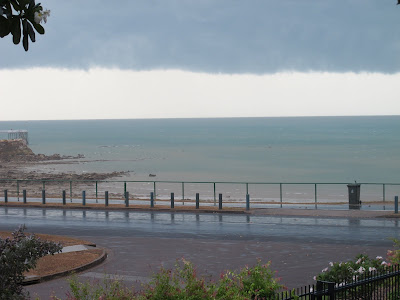


I have come back to stunning Galiwin’ku, Elcho Island, a tiny island in the Arafura Sea, almost swimming distance from the mainland.
I was here only a month ago, and it’s great to return so soon, to continue getting to know my adopted family.
The build-up to the wet season has definitely intensified since last time I was here, and I am appreciating the hire car (which we didn’t have last time), despite the tiny size of the community. The humidity makes us sluggish – adding to the exhaustion we feel at the end of each day spent speaking in/listening to a foreign language and finding the proper ways to behave in this vastly different culture, interpreting new signs and body language, respecting new boundaries, adjusting to the new concept of time.
This time we are here for an ear health project. It is my first time as a health educator, and talking about anatomy and physiology are proving to be refreshingly concrete after the abstract economic/social/political issues I’ve been focusing on this year. Australian Aboriginal languages don’t tend to use abstractions very often, making discussion of, say, “economic participation” incredibly challenging.
Aboriginal people, on the other hand, are more au fait with anatomy than we tend to be, being hunters etc. So it is no great leap from discussion anatomy to move onto discussing physiological function, if you find the right story line. So somehow over the course of this week I have found myself almost able to describe the entire anatomy and function of the ear in Yolŋu Matha. When I see a diagram of different parts of the ear I find myself knowing the Yolŋu Matha word before the English word, as that is the language I’ve acquired this new knowledge in.
But it is very exhausting, being immersed in the other language all day! It makes me remember being an exchange student in Chile, how I initially needed about 14 hours sleep to rest my brain, before I started thinking in Spanish.
So, the ear health field trip has come to an end for the time being, my colleagues are leaving tomorrow, and I am staying on for another five days. Maybe more language immersion (after a big sleep on the weekend!). I was hoping to do some education with Yolŋu women about the recently released federal government’s Indigenous Economic Development Strategy (http://www.indigenous.gov.au/ieds/) to follow on from some employment research I did last time.
But I’ve started reading the strategy, and it is rather depressing. Spin spin spin. When I have my community educator hat on, I read things differently to if I’m reading for political research, an article for Green Left Weekly, say. Each sentence I read, I wonder what it would mean to Yolŋu, how I would explain it to Yolŋu. And reading this new policy fills me with despair. How’s this for some incredibly abstract generative terms: “economic participation”, “social engagement”, “closing the gap”.
And that is before we start to look at the content, to discover the underlying meaning behind all the spin.
The more I read about the “closing the gap” initiative, the more I think when the government uses those words, it means “turning Aboriginal Australians into whitefellas”. I think it is more assimilationist bullshit. That doesn’t mean the goal of closing the life expectancy gap etc isn’t one worth fighting for.
But for the government, the way to do that seems to be to focus blindly on a few key benchmarks: Aboriginal people owning their own home, Aboriginal people working, Aboriginal people starting their own business.
What about the things we know really contribute to positive health outcomes? Aboriginal people being valued – as Aboriginal people, different to whitefellas, with different values; Aboriginal people having control and power over their lives and affairs; Aboriginal people not being an oppressed minority in a racist system Aboriginal culture being seen as inherently worthy; Aboriginal ownership and structures being recognised... Reckon that might help the health situation any?
Anyway I thought an interesting way to spend my days out here might be to find out what Yolŋu think about “closing the gap”. Have they heard about it? Do they know what it means? Do they agree with it? What would Yolŋu strategies for closing the gap look like? I wonder what the responses will be to the fact that the federal government used almost $100,000 of taxpayers’ money to design the “closing the gap” logo, on top on $1 million over 2 years to promote the initiative? (see http://tracker.org.au/2011/09/great-logo-but-program-a-no-go/)
In an interview with Yingiya Guyula published earlier on this blog, this is what he had to say about closing the gap:
"Let’s build a bridge to close that gap. That’s what I believe. Let’s build a bridge together. You don’t build it for me, we’ll build it together. "






































